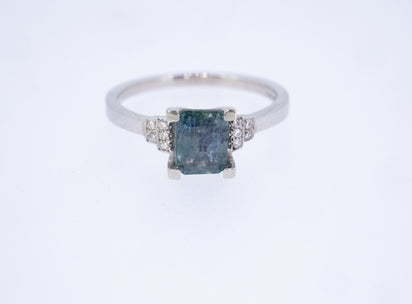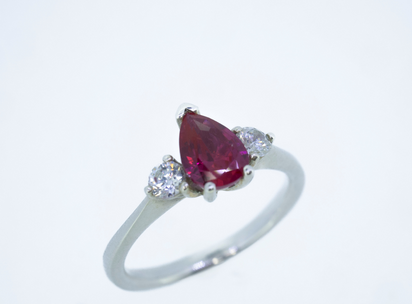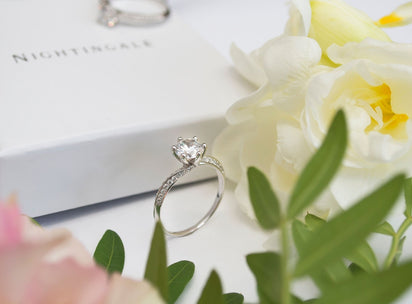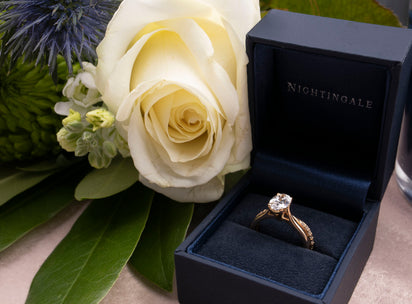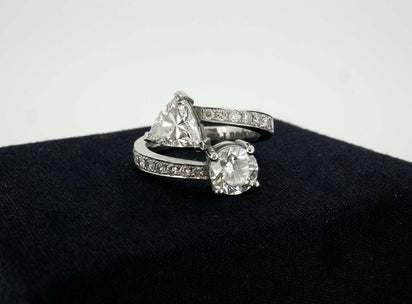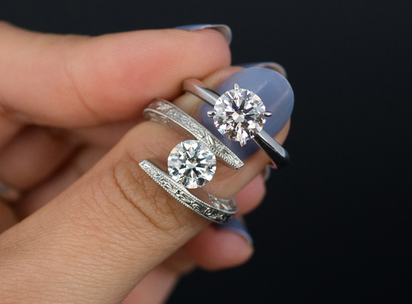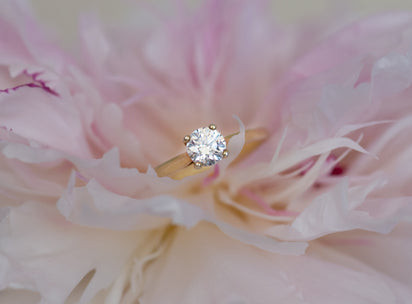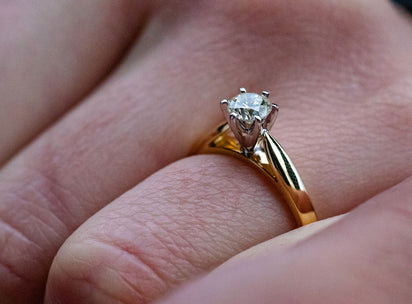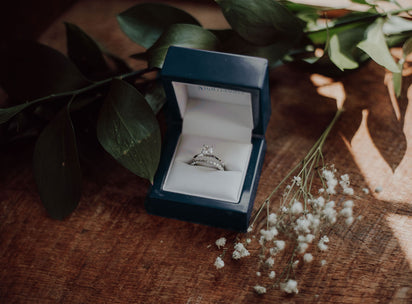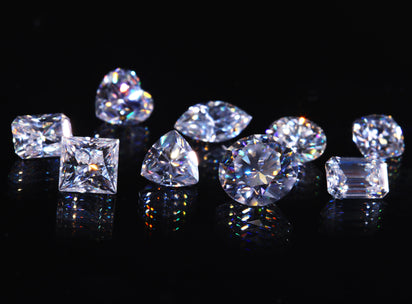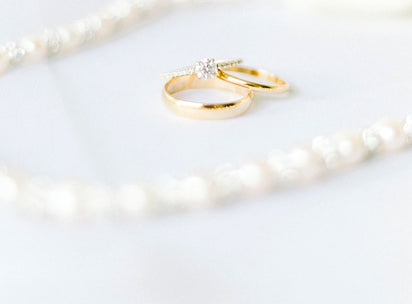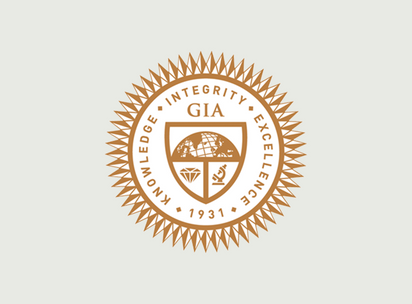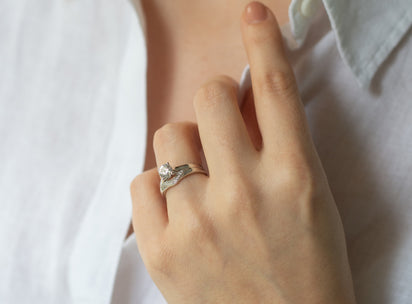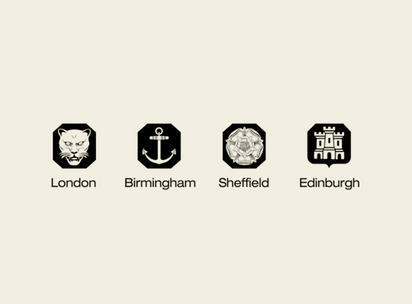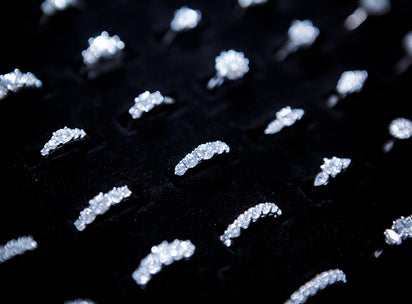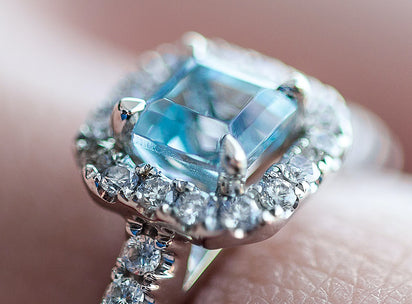How are emeralds graded?
Emeralds are assessed on the 4 Cs like most other gemstones: colour, clarity, cut and carat.
As with other coloured gemstones, colour is perhaps the most important in judging quality. However, clarity is also an extremely important quality to pay attention to for emeralds specifically.
Colour
We judge colour based on the hue, saturation and tone.
Obviously the hue needs to be primarily green, although you will find many that have hints of yellow and blue too. The tone needs to be a medium or dark green to qualify as an emerald, those with a lighter tone being classed as green beryl.
You’ll pay more for a deep green, saturated emerald than you would a paler one as the intense depth of colour is rarer and more desirable.
Clarity
Compared with other gemstones emeralds are a little softer measuring in at around 8 on the Mohs hardness scale. Diamonds top the scale at 10, with sapphires and rubies slightly below at 9.
As they’re a softer gemstone emeralds will typically have more inclusions and blemishes. It's exceptionally rare to find an emerald that has no surface markings or fissures. These emeralds are typically held as investment pieces or locked away as heirlooms as opposed to being worn.
For emeralds in fine jewellery, it is common and expected to have a number of inclusions which are visible to the naked eye. These are measured on a scale from AAAA (Best), AAA (Better) and AA (Good).
The more inclusions an emerald has, the more ‘mossy’ it will appear which can have a negative effect on it’s transparency and clarity.
You’ll sometimes hear this referred to as jardin (French for Garden).
Cut
Emeralds are typically cut into the signature Emerald Cut although you will also find them in oval shapes. Emeralds with different cuts (such as round) are typically uncommon because their relative softness can lead to chipping and poor light reflection.
Even rarer are pointed cuts such as pear and marquise because the risk of fracturing during the cutting process and chipping during general wear is simply too high.
The prevalence of inclusions is part of the reason you’ll see many lower quality emeralds cut in a cabochon (dome with flat bottom) style.
Carat
Carat weight follows the same basic rules as other gemstones, although it can be common to see emeralds measured in millimetres too.
What should I look for when buying an emerald?
Of all the grading criteria, colour is the most important for emeralds. You want a deep green hue with minimal amounts of yellow or blue tones.
You should also pay close attention to the clarity grading and select a stone with inclusions that don’t overly affect transparency.
A common mistake people make is comparing an emeralds clarity against that of a diamond, however this is like comparing apples to oranges. You can still get an exceptional quality emerald with numerous visible inclusions.
One thing to remember too is that almost all mined emeralds will undergo some sort of treatment to improve their clarity. Unlike diamonds, a treated emerald doesn’t indicate a lower quality gemstone.
As always, we’re here to help you find the right one!
Using emeralds in engagement rings
Emeralds are no doubt beautiful gemstones which look stunning mounted on an engagement ring, but there’s some practical things you should know about them before deciding to buy one.
Emeralds aren’t as durable as diamonds, sapphires or rubies
As we mentioned above, emeralds aren’t as hard as diamonds. In fact, they’re in a completely different league.
We measure gemstone hardness using the Mohs scale with a score of 1 - 10. Diamonds sits at the top with 10 and emeralds range from 7.5 - 8 depending on the variety.
The numbers themselves are fairly close, but the scale can be misleading. In practical terms diamonds are 100s of times harder than emeralds which generally makes them more suitable for engagement rings.
Emeralds are still fine for every day wear, but the likelihood of them being scratched and occluded over time is much higher than the other Big 4 gemstones.
Viable cuts are limited
Because emeralds are softer than other engagement ring gemstones they can be harder to cut into more complex shapes.
And because emeralds are rarer and more expensive than diamonds you won’t find as many gemstone cutters willing to attempt riskier cuts.
That’s why you’ll tend to only find emeralds cut using their signature style, the emerald cut. Oval and round cuts can be found, but they tend to have a higher risk of damage over time.
Emeralds are rarer and more expensive than diamonds
Diamonds are actually one of the more common gemstones, whilst good quality emeralds are much rarer. That’s why you’ll tend to see emeralds of a comparative quality priced higher than diamonds.
Finding ethical emeralds
The majority of emeralds come from Columbia. Anywhere from 50 - 95% of the world’s supply by most estimates (depending on the particular year and quality grade).
Zambia also contribute a significant amount to the world, with around 20% of gem quality coming from the African nation.
Being honest, these two countries don’t have the greatest of track records when it comes to responsible mining. Colombia has been in the midst of civil unrest for decades, whilst Zambian mine operators are in the process of being sued by citizens for causing massive pollution to local water supplies.
This can make finding truly ethical emeralds more difficult than other gemstones, but it’s not impossible.
Small scale ethical mines exist in both countries, but if you're looking for peace of mind when buying mined we'd suggest going with Brazil.
However if you want further assurances on ethical sourcing we recommend lab grown emeralds.
Before we talk about lab grown emeralds, one unique benefit of mined emeralds is the ability to trace their origin retrospectively.
Due to their unique characteristics and chemical compositions gemologists are able to identify where an emerald was mined with a relatively high degree of accuracy, although most sold by retailers don’t go through this process.
Lab grown emeralds
We’ve had the technology to grow emeralds in a lab since the 1800s, however it was such a difficult endeavour it is only recently become a more cost effective compared to mining them!
As with lab grown diamonds, lab emeralds are chemically and visually identical to their mined counterparts. Actually, one of the easiest ways to identify a lab grown emerald is that it’s likely to have a much higher clarity than those that come from the earth because the growing process isn’t as harsh.
How are they grown?
Emeralds are grown using a process called hydrothermal flux synthesis.
This involves using a beryl seed in a sealed, pressurised container filled with the minerals used to form emeralds naturally. Heat and an electric charge create the conditions for growth and an emerald is slowly grown from the initial seed.
This is a long process, taking around 60 days for a millimeter of growth. Because of this slow rate of growth lab grown emeralds are some of the most expensive of all lab grown gemstones.
To sum up...
We love emeralds and their distinctive style in engagement rings, but they're very different compared to buying diamonds so always go with a jeweller who knows their stuff!
Contact us now if you'd like to create your own ethical engagement ring with emeralds!
